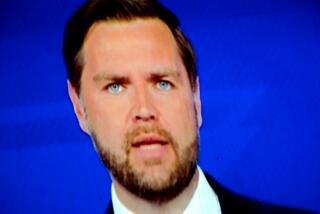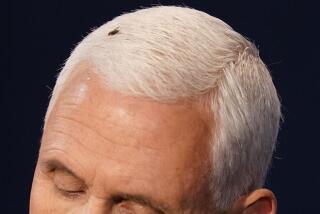3-Way Split Ups the Ante in Vice Presidential Game : Politics: Bush is set with Quayle, but the field is still wide open for tactical selections by Clinton and Perot.
- Share via
WASHINGTON — On the Republican side, the question of choosing a running mate is settled: Dan Quayle is on a rampage, blasting away at Murphy Brown and the so-called cultural elite.
Over among the Democrats, Bill Clinton is pondering--along with other possibilities--whether to pick a foreign policy specialist, such as Indiana Rep. Lee Hamilton, as his vice presidential candidate or go with a swing-state senator, such as Pennsylvania’s Harris Wofford. Meanwhile, Democratic National Chairman Ronald H. Brown worries that prospective presidential candidate Ross Perot might go with a black, such as Virginia Gov. L. Douglas Wilder, and steal away much of the Democratic Party’s most reliable constituency.
And from Perot headquarters in Dallas comes the broad hint--with no names attached to it--that if Perot had his druthers, his search for the best qualified understudy would end with a woman.
“A woman is a really good bet for us, I would suspect,” says James Squires, Perot’s press secretary. “There would be a lot of sentiment for that.”
What all this demonstrates is that while the vice presidency may not have been worth more than the proverbial pitcher of spit in the past, in 1992, the prospect of a three-candidate race endows the No. 2 slot with potentially extraordinary significance.
A triangular competition greatly complicates strategic considerations: Nearly every state and constituency comes into play, and each standard-bearer has reason to make the most of his running mate’s appeal. “In a three-person race, anything that helps define any of the candidates is important, and the vice president choice does that,” says former Vermont Gov. Madeleine M. Kunin, who is on the three-person panel chosen by presumptive party nominee Clinton to screen vice presidential choices.
Republican pollster Vince Breglio says that surveys in past elections show that a strong vice presidential candidate can add 1 1/2 to 2 percentage points to the vote for the ticket. “While that doesn’t sound like a great deal in a two-person race, in a three-way race, with the vote split up, it could be a big deal,” Breglio says.
Traditionally, the vice presidential candidate’s main role is to solidify the party’s base, which is what Quayle’s current round of liberal bashing is designed to do among conservative Republicans. In the process, the controversial Hoosier also seems to be solidifying his own place on the GOP ticket and undercutting speculation that he might be dumped.
As for the Democrats, “I think you ought to get somebody who would do at least two things: bring sort of a moral authority to the ticket and bring a relationship with the party’s base constituencies,” such as blacks and other minorities and organized labor, says Harold Ickes, Clinton’s convention manager.
Others recommend that the Arkansas governor choose a running mate who could help carry a key state. “I think the main thing is to find someone who can win a state you can’t win on your own,” says Harrison Hickman, who polled for Nebraska Sen. Bob Kerrey’s 1992 Democratic presidential campaign.
No Democrat comes closer to filling all these criteria than New Jersey Sen. Bill Bradley. But Bradley has been adamant about his unwillingness to run because of his pledge to New Jersey voters in the 1990 election to serve his full six-year term. Clinton and his advisers appear to be taking him at his word.
There is no shortage of other potential candidates, however. Hamilton is pushed by those who says his widely respected expertise on foreign policy would make up for what Clinton lacks in that area. But in terms of electoral votes, even Hamilton’s presence on the ticket would be unlikely to turn Indiana away from its rock-ribbed Republicanism.
Wofford, on the other hand, might give Clinton a better than reasonable chance of capturing Pennsylvania, with its 23 electoral votes, the fifth-largest prize in the nation. Wofford’s Catholic faith could help the ticket too. But his brief tenure in the Senate--he was elected only last November--is held against his candidacy by some.
Other senators being touted are Paul Simon of Illinois and John Kerry of Massachusetts. Both could help in their key states, though both might be overly liberal for Clinton’s centrist taste. Two others being mentioned suffer from the smallness of their states: Bob Kerrey of Nebraska, valued for his appeal to youth and his Vietnam War heroism, and West Virginia’s John D. (Jay) Rockefeller IV, admired for his probity and expertise on national health insurance.
With 1992 being heralded as the political year of the woman, Clinton advisers say that although they mean to give serious consideration to women prospects, the field is limited because the Democrats have no women senators. Some mention Colorado Rep. Patricia Schroeder, a 1988 presidential aspirant, and Rep. Nancy Pelosi of San Francisco, who is a chairwoman of the convention platform committee.
The two women governors who are Democrats are unlikely choices. Ann Richards of Texas is said to have ruled out the vice presidency, while Barbara Roberts of Oregon only recently survived a recall move.
Ordinarily a governor like Clinton would never consider another governor as a running mate. But 1992 is such an unusual year that some consideration is being given to Colorado’s chief executive, Roy Romer.
The Rev. Jesse Jackson’s supporters are urging his selection as a way of boosting turnout among blacks. But Clinton’s public criticism last week of black rap singer Sister Souljah at a gathering of Jackson’s Rainbow Coalition affronted Jackson and seems to have ended any talk of such a move.
The Jackson-Clinton split has stirred speculation that Perot might seize the opportunity to exploit this disagreement by selecting a black running mate himself--either Jackson or perhaps Wilder.
Though Democratic Chairman Brown recently confided his concern about such a move to a party activist, the ideological gulf between Jackson and Perot makes any union between them unlikely. And one key Wilder aide rejected the notion that the governor might leave his political home to sign on with Perot.
Still another rumor fostered by the intense interest in vice presidential selection is that Bill Moyers, a television commentator and former aide to President Lyndon B. Johnson, is being sought as a running mate by both Perot and Clinton. Moyers did not return phone calls on the subject and sources knowledgeable about both campaigns scoffed at the idea, though Clinton aides say that Moyers’ advice was sought about what qualities to look for in a vice presidential candidate.
As for Perot, he has by common agreement the most challenging task of all. Since so little is known about his own candidacy, his choice of a running mate will take on extra significance. One factor should make the process a little easier for him: Aides say he plans to make his decision after the Republican and Democratic conventions.
“The truth is that since we are starting up so late, we want to do everything last,” said press secretary Squires.
Matching the speculation about Perot choosing Democrats Moyers, Jackson or Wilder is the theory that he might go after Republican Jack Kemp, secretary of housing and urban development, who has made a name for himself by urging the Bush Administration to be more aggressive in dealing with urban problems.
Some analysts think it would be a mistake for Perot to pick anyone from either party, because that would blur the independent, nonpolitical image that undergirds his appeal. They suggest someone like Gen. Colin L. Powell, chairman of the Joint Chiefs of Staff, would be ideal, though few believe he is ready to leave the Pentagon for politics.
Any any rate, Perot’s senior adviser, Morton H. Meyerson, says that Perot is keeping all options open.
On the lists of prospects that Perot and his aides have been adding to and subtracting from for weeks, Meyerson says, “there are some people in both parties, there are some people from neither party and there some people who have served in public office but are neutral.”
And Meyerson says Perot has an open mind on what basis he will make his choice. “You could make a case that you want somebody who knows how Washington works as vice president, or you could make a case that you need to make a statement that you need to heal race relations or that you need to give women a chance to compete at all levels.”
Picking a woman running mate could turn out to be politically beneficial to Perot, whose generally high poll standings now suffer from something of a gender gap. But Squires says the undeclared maverick candidate has other reasons for leaning in that direction.
“He is interested in making the Perot Administration, if there was one, open to everybody,” Squires said.
According to Republican sources, one woman who has been approached by the Perot campaign is ex-Democrat and former U.N. Ambassador Jeane J. Kirkpatrick. But Squires said Perot’s search would extend beyond conventional political circles to the worlds of academics and philanthropy.
As examples of the type of woman who might be considered as a vice presidential prospect by Perot, Squires mentioned Linda Wilson, president of Radcliffe College, and Adele Smith Simmons, head of the John D. MacArthur Foundation, which supports creative efforts in science, the arts and the humanities.
But he added that he did not know whether either of these two women were actually being considered.
Times staff writers David Lauter and Thomas Rosenstiel and librarian Aleta Embrey contributed to this story.
More to Read
Get the L.A. Times Politics newsletter
Deeply reported insights into legislation, politics and policy from Sacramento, Washington and beyond. In your inbox twice per week.
You may occasionally receive promotional content from the Los Angeles Times.










